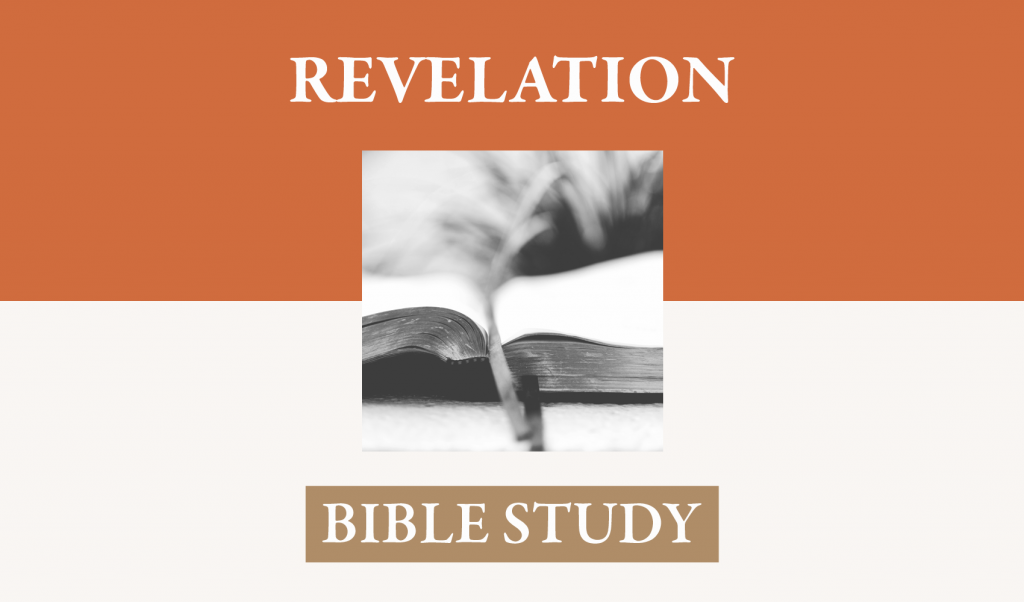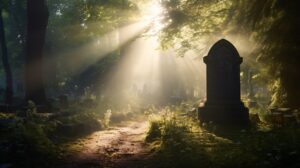After having delivered a message from Christ to the pastors, and through them to the churches, concerning how they should persevere in the earthly tests that have been set upon them, Christ now brings John into the heavenly sphere to see the unfolding of events from the perspective of heaven. His first revelation has to do with the place of divine power itself and how all beings, given this perspective, consent to the right and the wisdom of God in his rule.
A. A Call to Knowledge
Verse 4:1 – After this I looked, and behold, a door standing open in heaven! And the first voice, which I had heard speaking to me like a trumpet, said, “Come up here, and I will show you what must take place after this.”
John is now informed that he is going to be given a revelation of immediate and far future events from the perspective of heaven. Like the sound of a clear trumpet to battle (with no uncertain sound), the voice called him up for a look by revelation into God’s dealings with a sinful world hostile to God’s ways and his people. These events may seem fortuitous and at times may appear as if truth and righteousness are on the verge of being defeated, but this escapes neither the knowledge of God nor the purpose of God. Throughout the narrative, we will see that the heavenly view is quite distinct from the earthly view. Learning that the true and the real always comes from heaven and is always to be perceived in light of the divine perspective is a major part of the transformation of the mind that constitutes Christian discipleship. The pursuit of Christian doctrine as an outcome of an increasingly accurate knowledge of Scripture should be, not only a serious goal, but the joyful privilege of every Christian. Conversely this invitation should be seen in light of the warnings that accompany Wisdom’s invitation in Proverbs 1: “”If you turn at my reproof, behold, I will pour out my Spirit to you; I will make my words known to you. Because I have called and you refused to listen, have stretched out my hand and no one has heeded, because you have ignored all my counsel and would have none of my reproof, I also will laugh at your calamity; I will mock when terror strikes you, when terror strikes you like a storm and your calamity come like a whirlwind, when distress and anguish come upon you.” The revelation of terror comes in the context of the mocking self-confidence of a world in rebellion against it Maker and Judge.
Verses 2, 3 – At once I was in the Spirit, and behold, a throne stood in heaven, with one seated on the throne. And he who sat there had the appearance of jasper and carnelian, and around the throne was a rainbow that had the appearance of an emerald
By the Spirit, John was brought into a position of viewing a large number of inhabitants of the throne room of God. This could be similar to the experience Paul described in 2 Corinthians 12:1-5. In Paul’s case, what he saw could not be told; in John’s his task is to record these visions for the instruction of the churches. What does he see?
1. A throne stood in heaven – None of the supposed rulers of the earth are really in control, even over the little place for the little time that they have. The throne is in heaven and the will of heaven rules all the earth.
2. One is seated on the throne – His appearance can be described only in terms of great beauty, a combination of precious stones. His intrinsic glory is beyond description and cannot be beheld by mortal eyes. Moses learned this in Exodus 33:18-34:8.
3. This is a covenantal God as signified by the rainbow. Any time, so God said to Noah, that one sees the rainbow he should recall the covenant of God. It has the appearance of an emerald, lovely green, the color that symbolizes life. Though God is seated in a position of power, it is not a raw power unguided by the purposes of both justice and mercy. We are to understand, that all that comes before us now is in pursuit of the perfect execution of the covenantal purpose of God. Not only will his wrath and justice be displayed, but, by contrast, his infinite and unfrustrable mercies toward his people will become resplendent in their glory.
Verse 4 – Around the throne were twenty-four thrones, and seated on the thrones were twenty-four elders, clothed in white garments, with golden crowns on their heads.
Multiples of twelve, it seems to me, have to do with the apostles and patriarchs as representative of the elect of God, true believers in every age. We will find a similar symbol in the number 144,000. These thrones, 24 of them, show that all the believers of every age are, as it were, presently enthroned in heaven. So Ephesians 2 indicates that by Christ’s resurrection we are “seated with him in heavenly places.” In Colossians 3:1-3, we are assured that our affections are to be placed on things “above, where Christ is, seated at the right hand of God. . . . for you have died and your life is hid with Christ in God.” None of the following events can thwart the absolute certainty with which God will bring about the salvation of those whose names are recorded from before the foundation of the world in the Lamb’s book of life. Their clothing of white garments refers to their purity before God, both by Christ’s redemptive work, and by the purity of their lives, having been rescued from the corruption as well as the condemnation of sin. This vision gives substance to the promise to those few at Sardis that walked in white for they had not soiled their garments, that the “one who conquers will be clothed thus in white garments, and I will never blot his name out of the book of life” (3:4, 5) Their personal purity is assured as the end of sanctification occurs when they, the saints seated in the heavenlies in Christ, will be “like him for [they] shall see him as he is” (1 John 3:2, 3). The golden crown mean that as he has made us a kingdom and has promised that he has given us authority to judge the nations, so the emblems of such authority appear on these representatives of the whole number of the saints as an assurance that, as the world seems to judge them in the visions that follow, they will nevertheless see just judgment done on their behalf and with their full involvement (See 2 Thessalonians 1:5-9).
Verses 5, 6 – From the throne came flashes of lightning, and rumblings and peals of thunder, and before the throne were burning seven torches of fire, which are the seven spirits of God, and before the throne there was as it were a sea of glass, like crystal.
Psalm 29 begins, “Ascribe to the Lord, O heavenly beings, ascribe to the Lord glory and strength.” As the great power and majesty of God are described we find these striking ascriptions: “The God of glory thunders, . .the voice of the Lord flashes forth flames of fire, . . . The Lord sits enthroned over the flood; the Lord sits enthroned as king forever.” The heavenly beings are fulfilling the call of Psalm 29.
“Seven torches of fire, which are the seven spirits of God.” God is absolutely pure and nothing can pass toward his throne without passing through the purifying operations of the Holy Spirit. In this life a test of genuine salvation is that “by the Spirit we do mortify the deeds of the body.” This is reminiscent of the seven lamps that lighted the Tabernacle made of pure gold, fueled with pure olive oil (Exodus 37:23 and 27:20). The reason that white robes and clothing in Revelation most often symbolizes purity of life, and the righteous deeds of the saints, is that none can be in heaven apart from perfect purity. The warrant to heaven is only the righteousness of Christ imputed to us in faith; the condition of those in heaven is absolute purity before God for, those justified by faith, also “set their minds on the things of the Spirit” (Romans 8:5). They are thus progressively purified in this life, and finally purified before the throne of God when they enter into his presence.
“A sea of glass, like crustal” – There was a sea, a large vessel full of water, in the Tabernacle that served for the priests for ceremonial cleansing of themselves and the sacrifices. In Revelation 15:2, John sees a seal of glass mingled with fire, during a manifestation of the wrath of God. The sea of glass shows that in all of his actions, God is undisturbed. He has made perfect provision in the purity of the sacrifice he provided and his purpose will not be undone or impeded by anything. The mixture with fire indicates that the display of wrath is included in his immutable purpose. Here, the ”sea of glass, like crystal” shows that in the presence of God in heaven there is perfect order, beautiful and powerful and undisturbed.
Verse 6b – 8 – And around the throne, on each side of the throne, are four living creatures, full of eyes in front and behind: the first living creature like a lion, the second living creature like an ox, the third living creature with the face of a man, and the fourth living creature like an eagle in flight. And the four living creatures, each of them with six wings, are full of eyes all around and within, and day and night they never cease to say,
“Holy, holy, holy, is the Lord God Almighty,
who was and is and is to come!”
Speculation concerning the identity of the four living creatures demonstrates the difficulty of isolating the meaning of some of the images, and the danger of seeking too detailed and exact a correspondence. In light of the whole context of Revelation 4, it seems that they represent the entire created order, from a heavenly viewpoint able to understand with no equivocation that God’s infinite wisdom is behind his creation and providence. Their eyes, all around and within, represent the vision given to the entire creation of the reason for its subjection to vanity (Romans 8:22, 23) has now been made clear. There is no such groaning now from the heavenly viewpoint. In Isaiah 6:1-6, the seraphim had six wings and proclaimed God’s holiness to a disturbed Isaiah as the Lord, high and lifted up, sat on his throne. Now, earthly inhabitants with a clear vision of heaven have the same position, the same knowledge as the seraphim around the throne, and proclaim the same thing. Holiness characterizes the purpose of God in all that he does.
Verses 9 – 11 – And whenever the living creatures give glory and honor and thanks to him who is seated on the throne, who lives forever and ever, the twenty-four elders fall down before him who is seated on the throne and worship him who lives forever and ever. They cast their crowns before the throne, saying,
“Worthy are you, our Lord and God,
to receive glory and honor and power,
for you created all things,
and by your will they existed and were created.”
John is witness to an exultant and exuberant worship service in heaven. All creation in league with all the redeemed see nothing in the plan and purpose of God that is not worthy of the utmost rejoicing and gratitude. Nothing they see is inconsistent with God’s infinitely perfect attributes. In Romans 1, sinners left to themselves in their rebellion, “when they knew God, they glorified him not as God, neither were thankful” (Romans 1:21). The response of those in heaven, who are purified by the flames of the seven-fold Spirit of God, is one of utter subjection to divine wisdom and purpose. Their unclouded vision of God and his glory informs their praise. His position as Creator immediately puts him in the position of Lord of All. Nothing has existence that he did not bring into existence and nothing has perpetuity of existence that he does not sustain. For all of his acts of creation and providence, God is to be praised; there is no room for any question concerning either the goodness or the justice of God and no creature can call him to account.






















